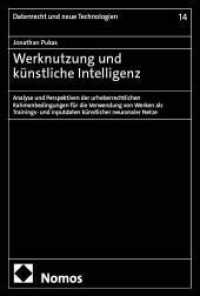- ホーム
- > 洋書
- > 英文書
- > Business / Economics
Full Description
This book brings together top recruitment and selection scholars to discuss recent challenges in employee recruitment and selection underpinned by research evidence from different European countries.
Broadly speaking, recruitment and selection are concerned with attracting qualified candidates to apply for available jobs and selecting the best ones from the pool of available candidates. As such, they are critical to any business. Numerous toolkits and best practice guides exist to help recruiters navigate different stages of recruitment and selection. However, traditional recruitment and selection practices should be adjusted to respond to diverse challenges in the current and future world of work related with increased volatility, uncertainty, complexity, and ambiguity. Specific examples of these challenges are related with the accelerated use of technology and artificial intelligence, as well as more flexible work practices, such as hybrid and platform-based work. The chapters in this volume cover the use of technology and gamification, applicant discrimination and stigmatization, and applicant reactions to technology-mediated selection methods, among others. This book is the ideal text for students, scholars and researchers of HRM, Business and Management and Organizational Psychology. It will also interest practitioners and professionals in the field.
The chapters in this book were originally published as a special issue of European Journal of Work and Organizational Psychology.
Contents
1. Paving the way for research in recruitment and selection: recent developments, challenges and future opportunities 2. Measuring the motive for power using conditional reasoning: some preliminary findings 3. Differentiated measurement of conscientiousness and emotional stability in an occupational context - greater effort or greater benefit? 4. Unravelling leadership potential: conceptual and measurement issues 5. Reducing ethnic discrimination in resume-screening: a test of two training interventions 6. Gamified or traditional situational judgement test? A moderated mediation model of recommendation intentions via organizational attractiveness 7. Using video- and text-based situational judgement tests for teacher selection: a quasi-experiment exploring the relations between test format, subgroup differences, and applicant reactions 8. Applicants' pre-test reactions towards video interviews: the role of expected chances to demonstrate potential and to use nonverbal cues 9. Managing organizational attractiveness after a negative employer review: company response strategies and review consensus 10. The interacting content and process of the employer brand: person-organization fit and employer brand clarity 11. Initial impression formation during the job interview: anchors that drive biased decision-making against stigmatized applicants 12. Laughter in the selection interview: impression management or honest signal?








